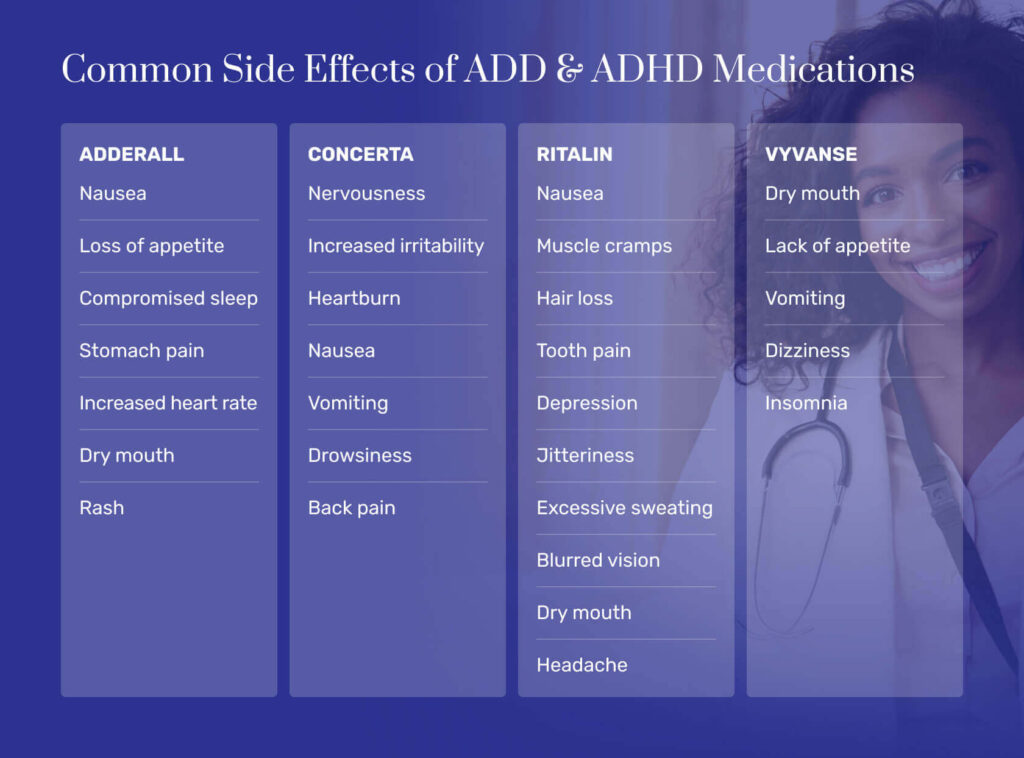Medication — such as Adderall, Concerta, Ritalin, and Vyvanse — is prescribed to both children and adults with attention deficit hyperactivity disorder (ADHD). Common ADHD symptoms include trouble focusing, restlessness, hyperactivity, and impulsivity.
When ADD and ADHD medications are prescribed, it’s very important to monitor the situation closely due to the fact that ADHD medication can lead to addiction when medication is abused. If misuse becomes difficult to control, Our Huntington addiction treatment center can help address dependency and support long-term recovery.
The Difference Between ADD & ADHD
ADHD (attention deficit hyperactivity disorder) is the official medical term for the condition, while ADD is a somewhat defunct term that was originally used to characterize inattentive-type ADHD. Symptoms related to what used to be associated with ADD included lack of organization, inability to focus, and forgetfulness.
Another way to think of it is ADD is used to describe certain features, such as an inability to focus, being easily distracted, and possessing a subpar working memory. ADHD is more associated with symptoms like being hyperactive and making impulsive decisions.
The medical diagnosis of attention deficit hyperactivity disorder includes both ADD and ADHD.
ADD & ADHD Medications
Medications taken to reduce symptoms related to ADHD work by boosting dopamine and norepinephrine production in the brain. As stated above, when taken in correct amounts, such medications help someone with ADHD increase their focus.
Medications for ADD and ADHD are referred to as stimulants. Not all stimulants are created equal. Some stimulants work as short-acting solutions lasting only a few hours in duration, while others can last around 12 hours.
Some of the most popular and commonly used stimulants include Adderall, Concerta, Ritalin, and Vyvanse.
Adderall
Adderall has been shown to increase focus while also decreasing hyperactive and impulsive behavior simultaneously.
Adderall is a central nervous system stimulant composed of amphetamine and dextroamphetamine. It has a relatively high success rate of around 70 to 80 percent for individuals with ADHD.
Adderall is commonly used to treat ADHD and narcolepsy, but it has also been shown to be useful in the treatment of depression particularly when used to augment other SSRI medication. Potential side effects include the following:
- Nausea
- Loss of appetite
- Compromised sleep
- Stomach pain
- Increased heart rate
- Dry mouth
- Rash
In rare cases, individuals have shown symptoms of aggression, mania, and psychosis when taking Adderall.
Concerta
Like Adderall, Concerta is a central nervous system stimulant that works by adjusting amounts of natural substances in the brain.
Concerta is an extended-release, long-acting tablet version of the stimulant methylphenidate. Concerta has a proprietary delivery system, which allows this medication to be released periodically.
Individuals who may benefit from Concerta are those who exhibit ADHD-related symptoms. Concerta helps individuals who have trouble focusing and controlling their actions. Like Adderall, Concerta can also be utilized for narcolepsy.
Concerta side effects include the following:
- Nervousness
- Increased irritability
- Heartburn
- Nausea
- Vomiting
- Drowsiness
- Back pain
More serious side effects include rashes, blistering of the skin, mood changes, seizures, hallucination, and difficulty breathing and swallowing.
Ritalin
Ritalin is also a central nervous system drug that contains methylphenidate hydrochloride as an active ingredient. Ritalin is fast-acting, usually lasting around 3 to 4 hours and regulating chemicals in the brain that affect behavior.
Ritalin side effects include the following:
- Nausea
- Muscle cramps
- Hair loss
- Tooth pain
- Depression
- Jitteriness
- Excessive sweating
- Blurred vision
- Dry mouth
- Headache
More serious side effects include paralysis, skin rash, constant flu-like symptoms, bleeding or bruising, and a sudden increase in body temperature.
Vyvanse
Like all the other stimulants mentioned previously, Vyvanse is a central nervous system stimulant that helps with fidgeting, lack of focus, and other ADHD-related symptoms. Vyvanse also works by regulating neurotransmitters, resulting in ADHD symptom relief.
Not only is Vyvanse used for the treatment of ADHD, but it has also been shown to be beneficial in the treatment of moderate to severe binge eating disorder.
Common side effects include the following:
- Dry mouth
- Lack of appetite
- Vomiting
- Dizziness
- Insomnia
More severe side effects include erectile dysfunction, paranoia, chest pain, numbness, and bruising or bleeding.

Comparing Stimulants for the Treatment of ADHD
Adderall, Concerta, Ritalin, and Vyvanse are classified as central nervous system stimulants (CNS).
These medications have been shown to alter levels of specific chemicals located in the brain, increasing attention, focus, alertness, and energy. CNS stimulants have also been shown to promote physical activity in some individuals.
These central nervous system stimulants will also generally raise an individual’s blood pressure, which results in an increased breathing rate and faster heart rate.
While Adderall and Ritalin are both fast-acting stimulants, Concerta and Vyvanse are both long-acting stimulants that are released into the body throughout the day.
Vyvanse is not amphetamine-based, unlike other stimulants. Vyvanse has a chemical composition and consists of lisdexamfetamine dimesylate, which is in the sympathomimetic amines class.
Concerta and Adderall differ in composition as well. Concerta has methylphenidate, while Adderall includes amphetamine salts as an ingredient. Adderall is a combination of amphetamine and dextroamphetamine.
Concerta’s effects tend to last longer, as it is released slowly over the course of the day.
Ritalin and Adderall, though similar, differ in their effects. Ritalin is quicker to work and doesn’t last as long, while Adderall works slower and stays in the system longer.
Alternatives to Stimulants for ADHD Treatment
Some individuals may seek non-stimulant alternatives for the treatment of ADHD. In many cases, parents will look for alternatives to stimulants for their child’s treatment.
Non-stimulant alternatives for ADHD treatment include atomoxetine, clonidine XR, and guanfacine XR.
Atomoxetine
Atomoxetine (Strattera) is an FDA-approved non-stimulant medication to treat ADHD. This selective norepinephrine reuptake inhibitor does not have the same potential for abuse that stimulant medication possesses. It is not classified as a control substance.
Clonidine XR
Clonidine is long-acting and approved by the FDA for the treatment of ADHD. Fast-acting forms of this medication are not yet approved by the FDA.
Guanfacine XR
Guanfacine is another long-acting medication that was originally used to treat high blood pressure. However, guanfacine has also been shown to help ADHD symptoms. It is considered a non-stimulant, and it is also not considered a controlled substance.
Non-Medication Approaches
On the more holistic side, non-medication-based approaches to ADHD treatment include lifestyle changes, especially when it comes to diet. Some studies find decreasing carbohydrate intake and increasing protein intake can reduce the severity and frequency of ADHD symptoms.
Yoga, mindfulness and meditation practices, memory training, neurofeedback, and different forms of counseling and therapy can also help to improve ADHD symptoms for some people.
Stimulant Abuse
Being that many ADHD medications are stimulants, there is a very high potential for abuse. The fact that stimulants increase focus and reduce the need for sleep makes them quite attractive for students, working professionals, and even those working long hours in the health care field.
Adderall, in particular, is popular among college-aged individuals. It is often used as a “study drug” for its ability to increase focus and decrease the need for sleep while prepping for exams. Adderall presents an attractive option, although it has not been proven that the drug is effective in improving learning capabilities, increasing retention, or resulting in better grades. In fact, studies show that it does not improve thought processes in college students who don’t have ADHD.
Signs of Stimulant Abuse
Abusing stimulants can drive up an individual’s heart rate, cause high blood pressure, and even result in a stroke. Stimulants often result in a lack of appetite and decreased need for sleep, which can result in a variety of short-term and long-term health issues.
Signs of Ritalin and Adderall abuse include the following:
- Increased anxiety
- Loss of appetite
- Panic attacks
- Headaches
- Chest pain
- Nausea
- Increased blood pressure
- Increased heart rate
- Hallucinations Seizures
When an individual is abusing stimulants, including ADHD medication, they are more likely to exhibit paranoid thinking as well as bizarre or suspicious behavior. Stimulants will result in loss of appetite and sleep loss, which can trigger symptoms like drowsiness, irritability, a pale complexion, and mood swings.
When to Seek Help
If you are using stimulants, such as Adderall or Ritalin, without a valid prescription or outside the parameters of your prescription, it is abuse. If you find you cannot stop this misuse, it’s time to seek help. If stimulant abuse has escalated or become unmanageable, our Massachusetts alcohol and drug rehab can provide structured care and evidence-based treatment.
There are currently no approved medications to treat stimulant abuse. Treatment includes detox and rehabilitation, medical evaluation, behavioral therapy, and other forms of treatment.
The goal is to address the underlying issues that led to your stimulant abuse and to learn coping mechanisms, so you don’t return to substance abuse in the future.
Avoiding Stimulant Abuse
The best way to avoid stimulant abuse is to only use stimulant-based medication as prescribed by an experienced health professional. Never use stimulants outside of prescribed parameters and avoid using stimulants simply for the need to stay awake.
Alternative ADHD treatments are available for those who do not wish to use stimulants, particularly those who have a history of drug abuse.
Staying transparent with your family, friends, and health care professionals will help to keep you accountable and decrease the likelihood of stimulant abuse. Educate yourself about the effects of stimulants and possible health risks that come along with stimulant abuse. The knowledge of potential risks will reduce the likelihood of stimulant abuse.
- ADD vs. ADHD Symptoms: 3 Types of Attention Deficit Disorder. (July 2022). ADDitude Magazine.
- Stimulant Medications for ADHD. (November 2021). Child Mind Institute.
- Adderall for Depression: What to Know. (January 2022). Psych Central.
- Methylphenidate. (January 2022). MedlinePlus.
- Ritalin® Tablet: Consumer Medicine Information. (November 2021). New Zealand Medicines and Medical Devices Safety Authority.
- Vyvanse. (August 2022). PsychCentral.
- Evaluating Therapeutic Effects of ADHD Medication Objectively by Movement Quantification With a Video-Based Skeleton Analysis. (September 2021). International Journal of Environmental Research and Public Health.
- Non-Stimulant Treatment for Attention Deficit Hyperactivity Disorder. (July 2005). Psychiatry.
- Ritalin and Adderall Abuse Fast Facts. (June 2022). United Brain Association.
- Atomoxetine: A Review of Its Use in Attention-Deficit Hyperactivity Disorder in Children and Adolescents. (2009). Pediatric Drugs.
- Safety and Efficacy of Clonidine and Clonidine Extended-Release in the Treatment of Children and Adolescents With Attention Deficit and Hyperactivity Disorders. (September 2011). Adolescent Health, Medicine and Therapeutics.
- Clinical Utility of Guanfacine Extended Release in the Treatment of ADHD in Children and Adolescents. (June 2015). Patient Preference and Adherence.
- Diet and ADHD, Reviewing the Evidence: A Systematic Review of Meta-Analyses of Double-Blind Placebo-Controlled Trials Evaluating the Efficacy of Diet Interventions on the Behavior of Children with ADHD. (January 2017). PLOS ONE.
- Diet Modification Impact on ADHD Outcome. (January 2021). Bulletin of the National Research Centre.
- Feasibility and Efficacy of Yoga as an Add-On Intervention in Attention Deficit-Hyperactivity Disorder: An Exploratory Study. (July 2013). Indian Journal of Psychiatry.
- Study: ADHD Drugs Do Not Improve Cognition in Healthy College Students. (July 2018). The University of Rhode Island.
- Do College Students Improve Their Grades by Using Prescription Stimulants Nonmedically? (February 2017). Addictive Behaviors.
















